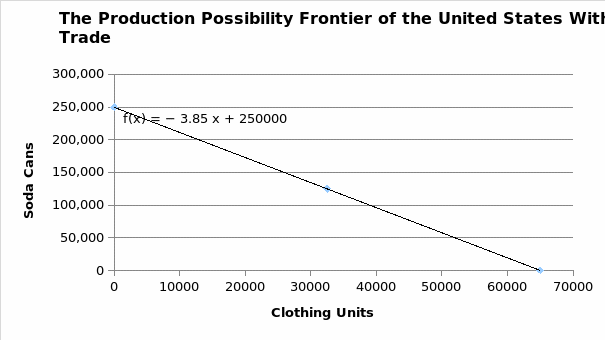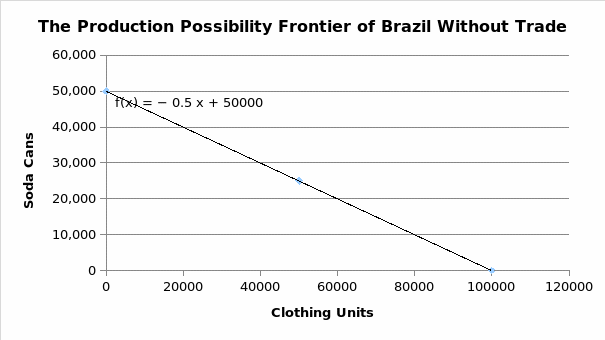Productive efficiency of an economy is dependent on its ability to mobilize and utilize its resources optimally. The production possibility frontier measures the amount of goods and services that an economy can produce using its available resources (Gillespie, 2016). The production possibility frontier varies from one country to another due to various economic resources such as capital, labor, and markets. For instance, Brazil and the United States have varied economic resources, which influence their production possibility frontiers. In this view, this essay seeks to compare the production possibility frontier of Brazil and the United States in producing clothing units and soda cans.
The Production Possibility Frontiers
The United States

Brazil

Specialization
Comparative Advantage
Comparative analysis of the production of soda cans and clothing units in the United States and Brazil shows different production efficiencies along the line of the production possibility frontier. Zenger (2016) argues that comparative advantage enables a country to produce goods and services at a lower cost when compared to its competitors. Based on the comparative advantage, the United States should specialize in soda cans, whereas Brazil ought to specialize in clothing units.
With zero production of clothing units, the United States has the potential of producing 250,000 soda cans. Thus, specializing in soda cans enables the Unites States to attain a higher production level than Brazil. In contrast, If Brazil sacrifices soda cans, it has the potential of producing 100,000 clothing units. In this view, specializing in clothing units allows Brazil to reach a higher production level than the United States.
Local Market
Additionally, the size of the local market for soda cans and clothing units differs between the United States and Brazil. The United States’ market can consume 125,000 of soda cans while the Brazilian market can consume 25,000 of soda cans. On the contrary, the Brazilian market can take 50,000 of clothing units, whereas the Unites States’ market can take 32,500 of clothing units. In essence, the United States has a broader local market for soda cans than Brazil, while Brazil has a broader local market for clothing units than the United States. Therefore, specialization would enable these countries to exploit and exhaust large local markets before exporting their products.
The Labor-Intensive Good
Comparison of the production process of soda cans and clothing units indicates that they vary in labor requirements. The production of clothing units requires more labor than the production of soda cans. The use of manual labor in the agricultural industry makes it labor-intensive, while the automation of processes styles the manufacturing industry as a less labor-intensive (Goswami & Mishra, 2016). As a developing Brazil country, Brazil has plenty of cheap labor, which is essential for it to specialize in the production of clothing units. In contrast, the use of advanced technology in manufacturing and expensive labor lets the United States to specialize in the production of soda cans.
The Marginal Rate of Transformation Impact
The examination of the slope of the production possibility frontier indicates that they have different opportunity costs. The marginal rate of transformation shows that the opportunity costs for clothing units in the United States is -3.85 and in Brazil is -0.5. The meanings of these opportunity costs are that the United States needs to sacrifice 3.85 soda cans, while Brazil requires to sacrifice 0.5 soda cans to produce a clothing unit. Thus, Brazil should specialize in the production of clothing units because it has a lower opportunity cost than the United States.
The Labor-Abundant and the Capital-Abundant Country
In this case, Brazil is a labor-abundant country because it is a developing country with the capacity to support and sustain the labor-intensive production of clothing units in the agricultural industry. In contrast, the United States is a capital-intensive country since it employs automated machines and technology in the production process. Thus, the abundance of labor allows Brazil to specialize in clothing units, whereas the abundance of capital permits the United States to specialize in the production of soda cans.
Trade and Poverty Reduction in Developing Countries
Trade plays a central role in reducing poverty in Brazil and other developing countries. Fundamentally, trade opens international market opportunities for individuals and firms to explore and exploit. Consequently, developing countries obtain foreign exchange earnings and improve their gross domestic product. Additionally, trade stimulates productive potentials of entrepreneurs and organizations due to increase flow of skills, knowledge, innovative products, and new markets.
According to Jain (2018), trade boost local manufacturing industry because it increases the inflows of foreign direct investment, technologies, and capital, which are insufficient in the developing countries. Thus, trade unlocks numerous economic opportunities for developing countries to interact with developed countries and explore effective trading avenues.
Conclusion
The analysis of the production of soda cans and clothing units in the United States and Brazil using the production possibility frontier indicates different opportunity costs. Comparative advantage and larger local markets allow the United States to specialize in soda cans and Brazil to specialize in clothing units. Moreover, a higher labor-intensiveness and a lower opportunity cost favor production of clothing units in Brazil, while a high capital-intensiveness and a higher opportunity cost encourage production of soda cans in the United States. Overall, trade alleviates poverty in developing countries because it allows them to explore and exploit global markets, stimulate local potentials, and boost the manufacturing sector.
References
Gillespie, A. (2016). Foundation of economics (4th ed.). New York, NY: Oxford University Press.
Goswami, A., & Mishra, A. (2016). Economic modeling, analysis, and policy for sustainability. Hershely, PA: USA Business Science Reference.
Jain, H. (2018). Trade liberalization, economic growth, and environmental externalities: An analysis of Indian manufacturing industries. New York, NY: Springer Verlag.
Zenger, T. R. (2016). Beyond competitive advantage: How to solve the puzzle of sustaining growth while creating value. Boston, MA: Harvard Business Review Press.